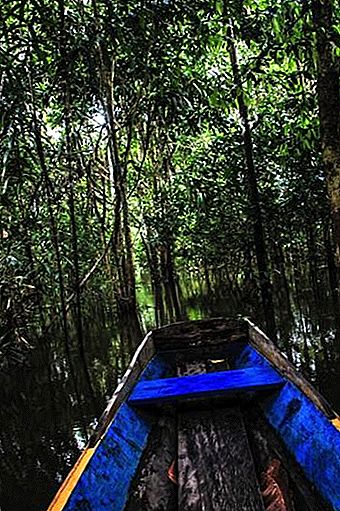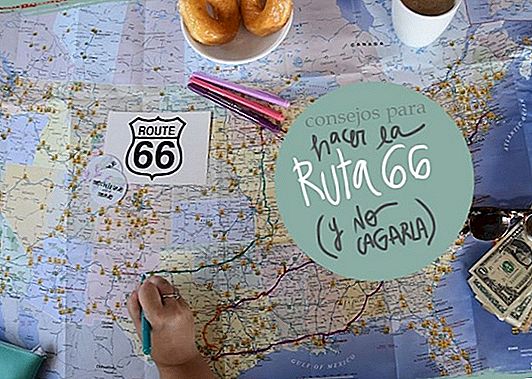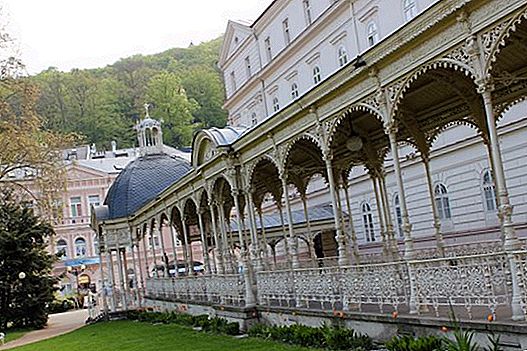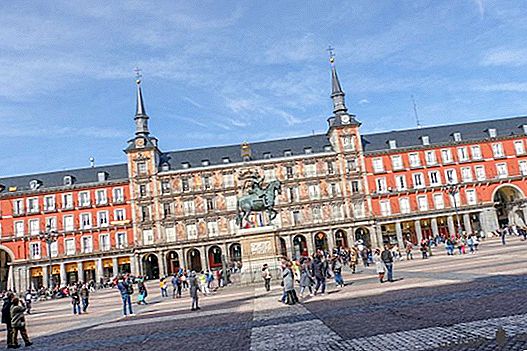Day 9: Lhasa: Potala Palace, Norbulingka and Sera Monastery
Today our day started a little later, about 7 in the morning and it is that yesterday, after touring many of the places we had scheduled to see in Lhasa, when we arrived at the hotel Pasang called us to make a small change of plans for today in the morning replacing the visit we had to Drepung Monastery, before visiting the Sera Monastery, for the visit to Potala's palace, that place, which is one of the great reasons for this trip to Tibet, where we have reserved the entrance at 9:30 in the morning.
We met Pasang and Tre at 9:15 in the morning, on the road where they left us the day we arrived at Lhasa from the Cloud Train to Tibet and that is very close to our hotel, the Tashitakge Hotel Lhasa, since As we said that day, the Barkhor area cannot be reached by car.
With these schedules, it is up to the hotel terrace to enjoy an excellent breakfast, not only for food, but for the incredible views we have of the Potala, which are giving us every morning the best way to start the day we could have imagine.

Views of the Potala
After breakfast, we return to the streets of Lhasa to meet Pasang, who is already waiting for us in the car next to Tre to go to the Potala's palace, where we arrived in less than 15 minutes.
As soon as we get out of the car and find ourselves, again in front of him, the first thing we look at is how much he changes when he sees it with the morning sky totally clear to how we saw him yesterday evening, when those who this season in Lhasa, the sky is usually cloudy.

Potala's palace
The idea is to return to this area of Lhasa or tomorrow or within two days, to enjoy it with much more tranquility and also, to be able to take photographs from all possible perspectives, since today we come especially to visit the interior.
And so we get in the queue of the east entrance and after doing about 15 minutes of queue, we access the Potala Palace enclosure, with a payment of 100RMB per person, which for us are included in the personalized trip to Tibet that we are doing from the hand of The China Guide, the agency that will accompany us throughout the trip.
Inside the Potala Palace you can not take pictures, only in open places, which are very few. It is for this reason that we practically do not have photographs of the interiors of the Potala and the rest of the Monasteries, something that we also partly appreciate since we have not been pending to try to take photos or worried about taking good images, allowing this to be only pending of all the explanations that Pasang has been giving us at all times and enjoy one of the most incredible places we have been lucky to visit on our trips.
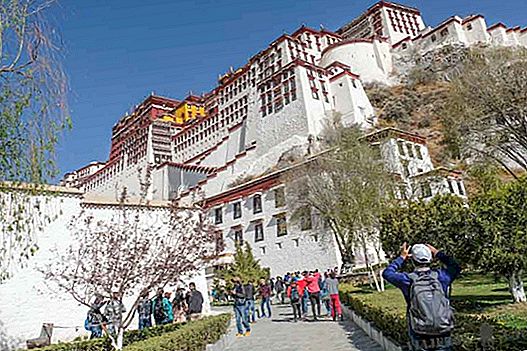
Entrance to the Potala Palace
Remember that any foreign traveler who wants to travel to Tibet must do so through an agency (IT IS IMPOSSIBLE TO TRAVEL TO TIBET FOR FREE), either by adding to a group or privately and having, before entering Tibet, a fixed route, that the agency will have submitted and must be approved by the Chinese authorities.
To obtain the visa and all permits, it is necessary that this itinerary be approved by the authorities. It is also not possible to modify the itinerary on the fly, something very important to keep in mind, as it will force you to be clear about what you want to visit from the first moment, since based on that, the agency will manage the permits.
In our case we have traveled with The China Guide, who managed all the permits after designing a personalized itinerary together, with a guide in Spanish and that has led us to enjoy as we had never imagined this magical place.
Today the Potala Palace does not have the activity that it has, for example, the Jokhang Temple, since it is uninhabited by what could be considered a museum, which reminds us, in a way, the way in which the Dalai Lama had to leave Tibet.

Access stairs to the Potala Palace

Potala's palace
The visit we have started approximately when it is 10 in the morning climbing the 400 steps that separate us from what is the first visit. Keep in mind that this, counting that we are over 3600 meters high, is not an easy task, so it is worth taking it easy and not making any extra effort.

Potala's palace
Another thing to keep in mind is that you cannot access with liquids or lighters and there are not many points of sale of water inside, only two: one right at the entrance and one at the highest part that is visit in the Potala's palace, so it is worth buying at the first access point, especially counting the amount of stairs there are. The price of water bottles is 5RMB, a more than adjusted price if we also take into account that the bottles are of special water for him Potala's palace.
The stairs take us, in more or less 15 minutes of ascent to the ticket offices of the Deyang Shar, the courtyard of the White Palace.
This is where you have to show the tickets and where in summer, start counting the only time you have to visit the Potala's palace, as Pasang explains to us, as of May the volume of visitors rises considerably and to avoid collapses the measure has been taken of leaving only one hour of visit in all the zones from this one.

Potala's palace

Potala's palace
This is where we find the only frescoes that can be photographed throughout the Potala, as well as some spectacular images of the snow lions, which can also be photographed.
From this point, cameras are prohibited in all interior places, in addition to being fully monitored by cameras and sensors.

Frescoes of the Potala Palace

Snow Lion Potala's palace
From here we continue the visit until we reach the roof of the White Palace where the private units of the thirteenth and fourteenth Dalái Lama are located.
Among them are the throne room, the reception room, the meditation room and the bedroom of the Dalái Lama, where you can see some personal items.

Potala's palace
From here we access the Red Palace, on the third floor, where we can see the Jampa Chapel, the three-dimensional Mandalas chapel, with three incredible mandalas, the Victory Chapel against the Three Worlds, with an incredible collection of books, the Chapel of Happiness and the tombs of the thirteenth Dalái Lama, which can now only be seen from the bottom, since the room above, from which you could have another perspective, is currently closed.
After this area we will see the tomb of the seventh Dalái Lama, made with more than half a ton of gold.
It is at this time when we visit what is considered to be the most sacred chapel in the entire Potala's palace, the Chapel of Arya Lokeshvara, which they tell us dates from when the Songtsen Gampo Palace was erected here in the seventh century and where the image of Arya Lokeshvara, the most revered of the Potala, is located.
At the end of this area we find the tombs of the eighth and ninth Dalái Lama, also incredible as the previous one.

Potala's palace
From here we go to the second floor where we find the Kalachakra chapel, with an impressive mandala, the Sakyamuni Chapel, with an incredible collection of books and the throne of the seventh Dalái Lama, the Chapel of the nine Buddhas of Longevity and the Hall of Meditation of King Songtsen Gampo.

Details of the Potala Palace
We pass to the ground floor of Potala's palace to visit the Chapel of Lamrim, where the different phases to reach the illumination are explained.
We continue the visit in the Rigsum Lhakhang Chapel, where you can see an image of Guru Rimpoche, and then reach the impressive and incredible Chapel of the Tombs of the Dalái Lama, where the tombs of the fifth, tenth and twelfth Dalái Lama are located.
The last visit we make is to the Chapel of the Sacred Succession, where we can see a statue of the eleventh Dalái Lama.
From here we take the exit that leads us down the stairs in the back of the Potala's palace, where we were yesterday afternoon, we went through commenting with Pasang how incredible everything we have been able to see and how impressed we are.

Leaving the Potala Palace
After the visit we have to say that the Potala Palace is an extremely incredible place and that you cannot get lost under any circumstances.
The visit we have started approximately when it is 10 in the morning and we have finished it when it is about 1 noon, so more or less it must be said that in total there are about three hours of visit, taking it easy , but without hurry or pause.

Views of Lhasa from the Potala

Views of Lhasa from the Potala

Views of Lhasa from the Potala
Tre, our driver, is waiting for us in the parking lot to take us to what will be the next visiting point of the day, Norbuligka, the Dalai Lama Summer Palace.
Norbulingka is located in Lhasa, quite close to the Potala Palace, only about 10-15 minutes by car, so it didn't take long to get there. After leaving the car in the parking lot, we head next to Pasang at the entrance to make this second visit of the day.

Norbulingka entrance
The price of admission to Norbulingka is 60RMB per person, which as for the Potala's palace We have already included.
We had read that this visit was not one of the most recommended in Lhasa. After our experience we have to say that having enough time, we believe that it is a complementary visit, to put it in some way to the Potala Palace and that, although not so interesting or impressiveIt is worth spending a couple of hours.

Norbulingka
The first palace we visited is the Palace of the Eighth Dalái Lama, which was his summer palace and all his successors, until the thirteenth.
After this visit we pass to the New Summer Palace, built by the current Dalái Lama (the fourteenth) and located in the central part of the park.

Norbulingka
Here we can see the audience chamber of the Dalái Lama, in which we enjoy some incredible frescoes that represent the history of Tibet.
As we said before and it has also happened to us in the Potala Palace, here the photographs are not allowed inside, so we have to fully enjoy all the explanations that Pasang is doing, leaving the cameras aside and trying capture the maximum details to keep them in our retinas.

Norbulingka
After this room we find the private rooms of the Dalái Lama, among which we can see his bedroom and the meditation room, which Pasang tells us, remain almost the same as they were left at the time of exile.
Then we pass through the meeting room, in which the Dalái Lama met and where we see a golden throne, several murals and several paintings.

Norbulingka
The visit to Norbulingka ends with a visit to the retreat zone of the thirteenth Dalái Lama, where we can see a statue of Chenresig, a large collection of books and a stuffed tiger, which we have to say, leaves us somewhat impressed.

Norbulingka
We finish this visit to Norbulingka when it is about 2:30 in the afternoon and we decide, after discussing it with Pasang, that instead of going to eat we will go straight to Sera Monastery, which is the third and last visit we have scheduled for today.
Today's route: Potala Palace, Norbulingka and Sera Monastery
The Sera Monastery is 6 kilometers from Lhasa, it is one of the great gelugpas monasteries, next to Drepung that we will visit the next day, which we will travel in about 30 minutes and the entrance fee is 50RMB per person.

Sera Monastery Entrance
After picking up the entrance and leaving the car in the parking lot, we enter the Sera Monastery, where once there were more than 5000 monks and that today have been drastically reduced to a few hundred.
The visit can be made at any time of the day, within the schedule, although we strongly recommend that you do it in the afternoon to make it coincide with the famous debates of the monks of the Sera Monastery, which take place from Monday to Friday from 3 to 5 pm approximately.

Entering the Sera Monastery
Today the Sera Monastery It is being restored, so many of the streets and many of the places are inaccessible, something that is expected, go for long.
The visit initially takes us to the Sera Me School, where we can see the main hall and a collection of incredible masks.

Sera Monastery

Sera Monastery

Sera Monastery
As most of the chapels begin to close at 3 p.m., Pasang takes us directly to the main meeting room, the largest building in the Sera Monastery and one of the reasons, together with the debates of the monks that has brought us here.

Sera Monastery main meeting room
The central hall of this meeting room is really impressive, where we cannot look away from all the details that we want to retain in our eyes, making the Thangkas and the Jampa statue 6 meters high make a real impression.

Sera Monastery
Seeing that it is almost 3:30 p.m. and listening to the sound of the monks' debate, we decided to go there, where Pasang is waiting for us at the door, giving us some indications about what we will see, so that we can understand each other. To explain to us that for some time now it is only allowed to take photos with mobiles since some time ago, there were people who came with cameras with enormous objectives and practically put them in the face of the monks, with the consequent loss of privacy that they suffered.
Given this, they decided that only photographs could be taken with mobiles, to avoid these unpleasant situations between visitors and monks.
For education and out of respect it would be convenient not to use the cameras since nowadays mobile phones make very good photos, and in addition, we also have to understand that since it is prohibited it is for something, so it should be taken into account.

Entrance to the courtyard in which the debates of the monks take place
Once we are inside we find a patio, divided into three zones, surrounded by a kind of wax, in which we place visitors.

Debate monks. Sera Monastery

Debate monks. Sera Monastery
As we move forward, we stop to observe two, three monks and thus try to keep the details of the discussions, so we can try to understand the guidelines that Pasang has given us about development.

Debate monks. Sera Monastery

Debate monks. Sera Monastery
We finished the visit to Sera Monastery when it is 4:15 in the afternoon and we talk to Pasang so that they leave us directly at the hotel and thus take advantage to go to eat, something that we should have done before, since at this time of the afternoon, we have joined the lunch with dinner, slightly messing up meals.
In order not to have to go around and also with Pasang's recommendation, we decided on the Phomdha Tsang Restaurant, former home of a teacher from the current Dalái Lama, which is next to the Tashitakge Hotel Lhasa and has a super nice patio where we sit And we enjoyed a yak steak and a yak pizza, plus soda, beer and two coffees for 162RMB.

Dinner at Phomdha Tsang Restaurant
And so, almost without realizing it and after the desktop, it's almost 7 in the afternoon, at which time we decided that today has come to an end, at this point it is not convenient to force the machine too much and even more when We have 3 days left in Lhasa to continue getting to know the city, going straight to the Tashitakge Hotel Lhasa, where we fall in the soft bed of our room.
 Day 10: Drepung Monastery and Jokhang Monastery in Lhasa
Day 10: Drepung Monastery and Jokhang Monastery in Lhasa
 Remember that any foreign traveler who wants to travel to Tibet must do so through an agency (IT IS IMPOSSIBLE TO TRAVEL TO TIBET FOR FREE), either by adding to a group or privately and having, before entering Tibet, a fixed route, that the agency will have submitted and must be approved by the Chinese authorities.
Remember that any foreign traveler who wants to travel to Tibet must do so through an agency (IT IS IMPOSSIBLE TO TRAVEL TO TIBET FOR FREE), either by adding to a group or privately and having, before entering Tibet, a fixed route, that the agency will have submitted and must be approved by the Chinese authorities.